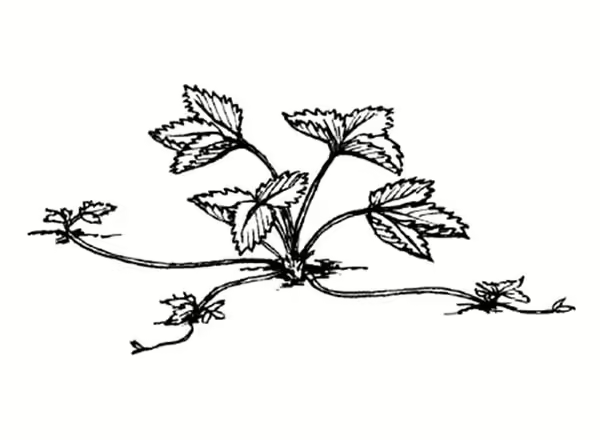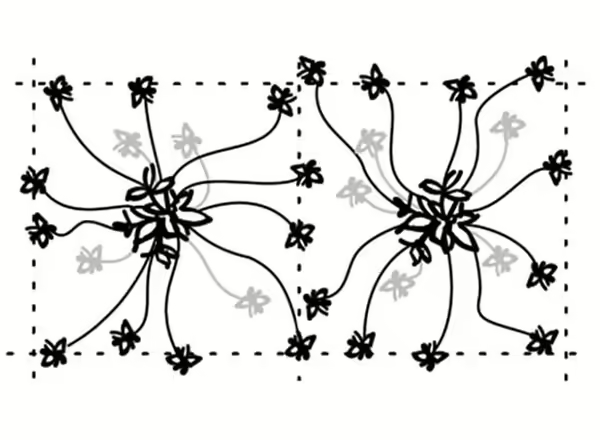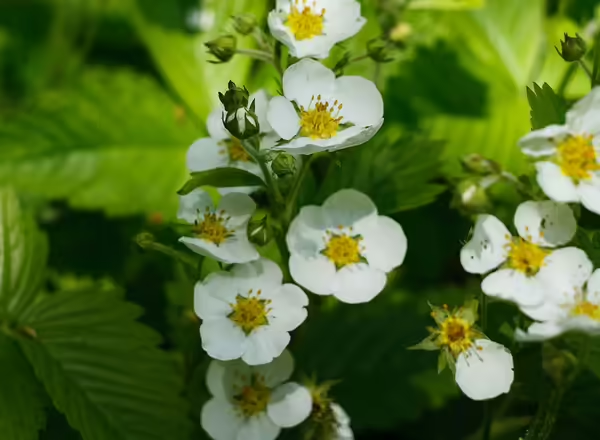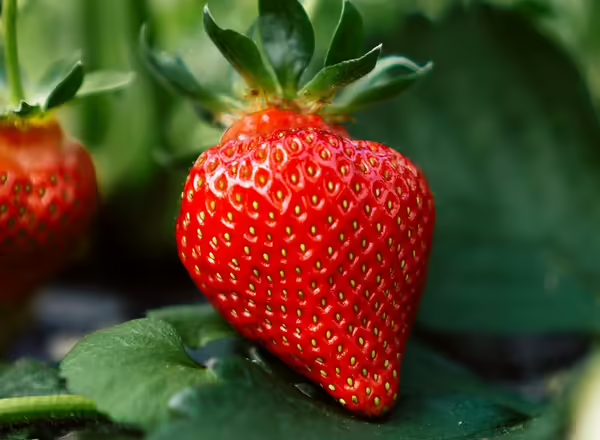
Strawberries should be planted as soon as the ground can be prepared in the spring. Do not plant if the soil is wet.
- Planting is best done in March or April in Illinois to allow the plants time to become well established before the hot summer weather begins.
- If possible, the plants should be set during cloudy weather or during the late afternoon or evening.
- Set the plants to the proper depth and apply one pint of water per plant.
- Within four to five weeks, mother plants will produce runners and new daughter plants.
Matted Row Systems
The matted-row system is the most popular method for growing June-bearing (standard) cultivars in Illinois. The plants should be set eighteen to thirty inches apart in rows that are three to four feet apart. The daughter plants are allowed to root freely to become a matted row no wider than two feet.
Spaced-Row Systems
Spaced-row systems limit the number of daughter plants that develop from a mother plant. Under this system, the original mother plants are spaced the same as before, but the daughter plants are spaced to root no closer than four inches apart. All other runners are cut from the mother plants. Such spacing gives optimal growing conditions because strawberry rows can often be too dense for good production. Spaced-row culture requires more care than matted-row plantings, but higher yields, larger berries, and fewer disease problems may justify the extra effort.
Hill System
The hill system is the best method to grow everbearing and day-neutral cultivars. All runners are removed so that only the original mother plant is left to grow. Runners develop from the same region as flower stalks, so runner removal enables the mother plant to develop numerous crowns and more flower stalks. Multiple rows are often arranged in groups of two, three, or four plants with a two-foot walkway between each group of rows. Plants are set one foot apart in the multiple rows. The planting should be cultivated and hoed for the first two or three weeks; then the entire bed may be mulched. Sawdust or wood chips or even layers of newspaper laid flat be- tween plants may be used as soil mulch during the growing season. Apply sawdust or corncobs in a layer one to two inches deep. About four cubic yards are needed to cover 1,000 square feet.




Remove flower stems as early as they appear from newly set plants during the first summer. Allowing the fruit to develop during the first season delays root and runner development and reduces the crop the following year. Flowers that develop after July on everbearing and day-neutral cultivars can be left to produce a crop later in the fall.

Strawberries are among the most widely grown fruit in the home garden. Strawberries prefer a well drained soil, high in organic matter. They need full sun for the highest yields, at least 6 hours per day. Do not plant strawberries where peppers, tomatoes, eggplant and potatoes have been grown. These plants could harbor verticillium wilt, a serious strawberry disease. Strawberries need about one inch of water per week during the growing season.

Strawberry plants should be fertilized in early August with four to six pounds of ammonium nitrate (33% nitrogen) fertilizer, or equivalent, per 1,000 square feet. This amount of nitrogen (one tablespoon spread in a narrow band about three inches from the crown of each plant) may also be applied about a month after planting if the plants are not vigorous. The August application may be broadcast over the rows but only when the foliage is dry. Brush the foliage with a broom or rake immediately after application to remove fertilizer particles; if left, the fertilizer particles may burn the leaves. Irrigate to carry fertilizer down into the root zone.
Be careful when applying fertilizer. Too much will cause excessive vegetative growth, reduce yields, increase losses from fruit and foliar diseases, and result in winter injury. Application of fertilizer during the spring of a fruiting year can produce soft berries and is not recommended.

Cultivation and hand hoeing should begin soon after the plants are set. This practice will control weeds and make the soil more suitable for runner plants to take root. Repeated cultivation every seven to ten days is effective against weeds because weeds are easier to kill when they are small. Cultivation should be shallow around the plants to prevent injury to the roots.
Chemical herbicides can be used to control weeds, but they may be impractical for small gardens. If herbicides are used, follow the spray schedule in University of Illinois Extension Pest Management for the Home Landscape.
Strawberries should be mulched during the winter months to protect the plants from extreme cold as well as to reduce damage from frost heaving that occurs when the soil alternately freezes and thaws.
Mulching also conserves soil moisture, keeps the berries clean, and provides better picking conditions. Use a loose organic material such as clean, seed-free wheat straw. The straw also can be used to cover the plants temporarily during cold nights in the spring to protect the flowers from frost injury.
Apply straw mulch after several frosts in the fall, but before the temperature drops below 20° F. This generally occurs between mid-November and mid-December in Illinois. If using heavy equipment, it is best to wait until the ground is frozen. Apply 100 to 150 pounds of straw per 1,000 square feet (two to four bales) three to four inches deep over the rows. If the straw blows off of the plants, it should be raked back on them.
Remove part of the straw in the spring before new growth starts after the soil temperature remains at 40° F for at least three or four days. Put the excess straw between the rows.
Properly managed strawberries will bear fruit more than one year. Usually a patch may be picked two to four years or more, but only good plantings should be maintained. Weedy or diseased plantings are best destroyed and replaced.
Immediately after the harvest is complete, the strawberries grown on the matted-row system should be renovated to achieve good production the next year. Mow the old foliage with a power mower, cutting off the leaves about one inch above the crowns. Rake the leaves and other debris from the patch and burn, compost, or incorporate them in the soil. To avoid spreading leaf diseases, do not return the leaf mulch compost to the strawberry planting. Do not mow the leaves if renovation cannot be completed within a week to ten days after harvest. Broadcast ten to fifteen pounds of 10-10- 10 or 12-12-12 fertilizer, or equivalent, per 1,000 square feet over the planting. Narrow the rows to six to twelve inches wide by spading, hoeing, or rototilling. Eliminate all weeds by hoeing or cultivating. If the remaining plants in the narrowed row are too crowded (closer than four to six inches apart), it may be advisable to remove some of them. If an herbicide is used, apply it carefully and as directed on the label. Irrigate thoroughly to encourage the plants to recover and make new runners for the next season’s crop.
Day-neutral and everbearing strawberries are usually grown in a hill system (Figure M-8.). Home gardeners who have limited space may grow these strawberries in terraced beds, pyramids, or barrels. These strawberries also make good edging plants or ground covers in the landscape. Sometimes they are grown as potted house plants or trained on “totem poles.” If grown indoors, the plants must have good light, and the blossoms must be pollinated by hand to form well-shaped berries. Although these methods are not as productive as conventional systems, they do have ornamental value.
Strawberry buds, blooms, and immature fruits are very susceptible to frost and freezing damage in the early spring.
These losses can be lessened or prevented by covering the plants with straw or other insulating material or by careful and timely application of irrigation water. Irrigation water should be applied continuously when the temperature at the plant level reaches 34° F.
Remember, because warm air rises and cold air sinks, the air temperature above a planting can be considerably higher than at the ground level. Sprinklers that put out a minimum quantity of water (0.1 to 0.3 inches per hour) should be used to prevent unnecessary flooding. A finely perforated plastic hose may also be used. Water will freeze on the plants and blossoms; the blossoms will not be injured as long as water is applied during the entire freezing period. This system is effective down to temperatures of 25° F or lower. Once irrigation has begun, it must be continued through the night and into the next morning until all of the ice has melted from the plants.
Straw from between the rows may also be raked over the plants for protection. In small home patches, the placement of old blankets or sheets can often insulate the plants enough for them to survive frost. If this system is used, remove the covering (especially straw) during the day, and cover the plants on nights only when there is danger of frost. Spun bond material is available commercially to serve as a blanket over entire rows and will protect plantings down to temperatures of about 23° to 25° F.
Root-feeding Pests
The most common root-feeding pests of strawberries in Illinois include the strawberry crown borer, Tyloderma fragariae; the strawberry root weevil, Otiorhynchus ovatus; and white grubs in the genus Phyllophaga. Other below ground pests, including the strawberry rootworm, Paria fragariae, and strawberry root aphid, Aphis forbesi, are rarely economically important in Illinois. Although the crown borer, root weevil and grubs are all members of the insect order Coleoptera (the beetle and weevils) their life histories differ considerably.
Foliage-feeding Pests
The foliage-feeding pests of strawberries in Illinois include leafrollers (strawberry leafroller and others), the strawberry rootworm and two mite species—the two-spotted spider mite and the cyclamen mite. This summary reviews the life histories of these pests and the practices that can be used for their management. Other foliage-feeding pests, including the grape colaspis and strawberry sawflies rarely damage strawberries in Illinois and are not covered in this paper. Information on these less common pests is summarized in Insect Pests of Strawberries in Ohio (Williams and Rings, 1980).
Flower and Fruit-feeding Pests
The common flower and fruit-feeding pests of strawberries in Illinois are the strawberry clipper, the tarnished plant bug, the strawberry sap beetle and slugs. In 1994 the eastern flower thrips, an insect that rarely causes significant losses in strawberries, appears to have caused severe damage to the crop in much of the east-central United States.